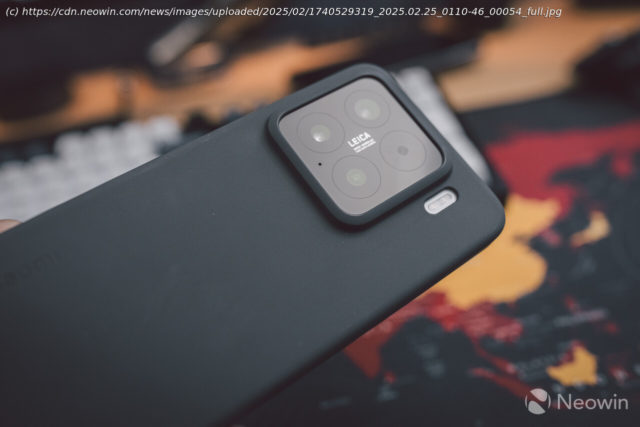This Xiaomi 15 boasts Leica optics, 50W wireless and 90W wired charging, Snapdragon 8 Elite, superb build quality and ergonomics, but is it worth the £899 starting price?
Back at the start of February, we reported on the Xiaomi 15 Ultra, the top-tier version of the new 15 family. Meanwhile, those looking for a slightly more affordable flagship option should read on because the Xiaomi 15 might be what they are after.
I will be covering my thoughts on the UK release, but as there is no longer any obvious regional difference for the hardware, everything mentioned here would apply to the rest of the global release, too.
I have been using the Xiaomi 15, which I will just call the ’15’ from here onwards, for nearly a couple of weeks alongside my Pixel 9 Pro XL, chiefly to compare both performance differences in day-to-day popular app usage (the 15 uses the latest Snapdragon 8 Elite, while my Pixel makes do with Google’s Tensor G4) and of course my bread and butter, the cameras, because at a £770 starting price here in the UK, if the camera can’t at least match a Google Pixel, then is it even worth considering if you are a content creator? Let’s find out.
I was sent the 12GB RAM version sporting 512GB of storage. There is a 16GB/1TB option, too, but it is only available in some other regions.
JN5 image sensor – 50 MP, f/2.0, 60 mm, PDAF (10 cm – ∞), OIS, 3x optical zoom
Unboxing was nothing too special. The usual Xiaomi niceties, such as a pre-installed screen protector and the inclusion of a high-quality case, mirror my unboxing experience of the Redmi Note 14 Pro+ 5G.
Some regions get the 90W charger in the box, but sadly, Europe is not one of those. Buying the official charger will cost an additional arm and leg, so I recommend buying one of the many 100W+ wall warts from the likes of UGREEN, Anker and so on, as you will get the full 90W the phone is capable of since the USB-PD 3.0 standard is being used here.
For reference, all my wired fast-charging testing was done using a CUKTECH 10, which is a 150W power bank, and the official Xiaomi 50W Wireless Charging Stand Pro.
The finishing on the back panel is especially worth paying attention to. Unlike other phones, this has an almost chalk-like texture to it. It’s not as smooth as an iPhone, Galaxy, or Pixel—it has some friction under the fingernail, yet it is still glass.
It does not appear to be pure white under strong lighting, either. Instead, it has a very subtle depth to it, which is hard to capture on camera. This is something I have not seen on another phone before.
The mid-frame is matte finished with a thick-feeling texture in similar vain to the back panel, and the edges of the area of the frame meeting the back panel seamlessly curve and blend to meet each other. Under the fingers, this seam feels like it’s one piece and can only be felt with a fingernail running over it.
This is a level of attention to detail that is not often seen, although, to be fair, this is exactly what I expect to see when paying £700+ for a phone.
Unlike the Redmi series, the Xiaomi flagship series this time does not skimp on things like battery capacity or cameras, which were higher-specced in some Asian markets.
The 5,240 mAh battery is bigger than the 5,000 mAh in my Pixel Pro XL and even the Galaxy S25 Ultra. It’s pretty amazing that the extra capacity has been crammed into a smaller handset while still retaining all of the expected features expected from a modern flagship phone. On top of that, we have 90W wired charging and 50W wireless.
I think Samsung and Google could take some notes on how not to be stingy whilst they charge more for less in this particular area, as neither has seen any form of an upgrade in battery tech in a very long time.
Since battery chat is fresh on the mind, I may as well get this section out of the way. I did some extensive testing on battery charging times with the 15 now that I have Xiaomi’s 50W Charging Stand Pro:
Although, ironically, I joked about Samsung and Google being stingy above, and here we are with a wireless charging stand that retails at £79 and does not come with a suitable power adapter. I ended up using my own 65W GaN by Anker.
In testing, it got the 15’s battery from 9% to 100% in 1 hour and 22 minutes, and that was with frequent checks of the charging rate by waking the screen up, which reduces charging speed or lifting it off the stand to check hotspots and general thermal conditions.
Charging at 50W wirelessly resulted in no excess heat on either phone or pad beyond what we already see these days with 15W wireless charging, thanks to the Pro stand’s active cooling system that kicks in when a 50W output is initiated. Do note that the stand only outputs 10W and 50W according to the label on the back, so there is only a choice of slow wireless charging or super fast with this. A 65W PD power adapter is needed to get the full 50W; for the 10W output, a 30W PD adapter is required, which will typically be a 45W wall charger.
The 50W is impressive, wireless charging of a 5,240 mAh battery that is faster than wired charging on smaller batteries found on the Galaxy S25 Ultra and Pixel 9 Pro XL flagships.
The 15’s battery will easily last a full day of heavy use. As mentioned in past reviews, battery drain testing isn’t really needed anymore, as the vast majority of phones last a full day. All that matters is whether you can do a quick charge before heading out the door. At 50W and 90W, yes is the answer here. Just remember that as you approach 80% charged, the rate drops massively to protect the cell from early death.
The LTPO AMOLED panel brings nothing new to the table for the series.
Home
United States
USA — software Xiaomi 15 Review: The new flagship series with Snapdragon 8 Elite and...






